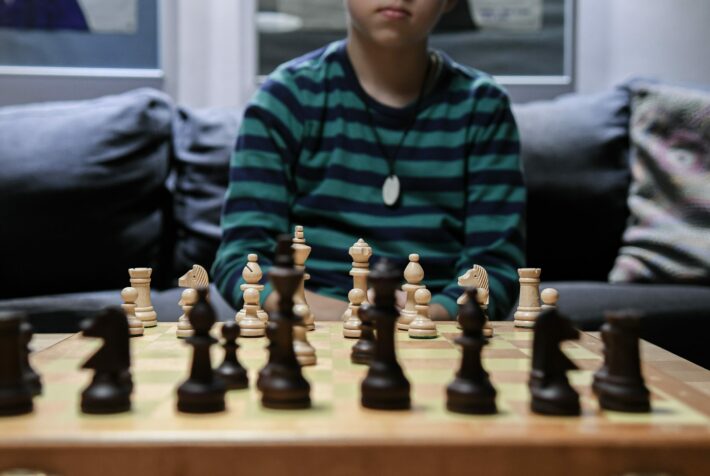In the intricate game of chess, there exists a fundamental question that sets the stage for strategic battles and intellectual prowess: who goes first? The answer may seem simple, yet it holds profound significance in shaping the course of the game. Understanding the rules and principles governing the determination of the first move is crucial for both novice players and seasoned grandmasters alike.
In this comprehensive guide, we will delve into the intricacies of this chess etiquette, exploring the historical background, the role of color, and the various methods employed to decide who takes that pivotal initial step on the 64-square battlefield. Prepare to unlock the secrets behind this age-old chess conundrum and gain a strategic advantage from the very first move.
What is the significance of determining the first move in a game of chess?
The first move in chess sets the tone for the entire game, providing a strategic advantage to the player who goes first. It allows them to dictate the initial positioning, control the center, and potentially launch an aggressive attack. The player who goes first gains an opportunity to shape the course of the game, putting pressure on their opponent and forcing them to respond.
Making a strong opening move can establish control, create tactical opportunities, and lay the foundation for a successful game plan. Thus, the significance of determining the first move cannot be underestimated in the dynamic world of chess.
How is the player who goes first determined in chess?

The player who makes the first move in chess is determined through a simple rule: White moves first. White, represented by the light-colored pieces, always gets the privilege of initiating the game.
This convention has been established to maintain fairness and ensure equality between players. By giving White the first move, the game starts on a balanced footing, providing opportunities for both players to showcase their skills and strategies. It is important to note that this rule applies to standard chess games and may vary in certain chess variants or adaptations.
Are there different rules for deciding who goes first in chess tournaments?
In chess tournaments, the rules for determining who goes first are typically standardized. The standard rule follows the convention that the player with the white pieces moves first. This ensures consistency across tournaments and promotes fairness in competition.
However, in specific cases, such as rapid or blitz chess, different rules may be employed, such as alternating colors or using coin tosses, or drawing lots to determine who moves first. Tournament organizers adhere to these rules to maintain uniformity and create a level playing field for all participants.
Does the color of the pieces have any influence on who makes the first move in chess?
Yes, the color of the pieces influences who makes the first move in chess. The player with the white pieces always moves first, while the player with the black pieces responds. The choice of colors is arbitrary but consistent throughout the game.
Although the color itself does not impact gameplay or strategy, it serves as a visual distinction to differentiate between the two sides. The significance lies in the player’s ability to capitalize on their position, regardless of the color they are assigned, rather than the inherent influence of the color itself.
Are there any historical reasons behind the rules for determining the first move in chess?
The historical reasons behind the rules for determining the first move in chess are deeply rooted in tradition and strategic considerations. Early versions of chess had no fixed rules for determining who moved first. However, as the game evolved, the convention of White moving first emerged.
One historical theory suggests that it originated from the notion of chivalry, where White symbolizes the player with the advantage. Another theory proposes that it is linked to the way chess was played in ancient Persia, where the person playing as White was considered the host or superior player. Regardless of the exact origin, these historical factors contributed to the establishment of the current rule.
Can the player who goes first in chess gain a strategic advantage?
Yes, the player who goes first in chess can indeed gain a strategic advantage. The first move provides an opportunity to shape the game’s development, influence the board’s control, and set the tempo. By making a strong opening move, the player can seize the center, activate their pieces, and potentially launch an attack.
Additionally, the player who moves first can force their opponent to react and adapt to their chosen strategy. However, it’s important to note that chess is a game of balance, and even though the player going first has certain advantages, the opponent also has opportunities to counter and equalize the position.
Are there any strategies or tactics associated with being the player who makes the first move in chess?
Certainly, there are numerous strategies and tactics associated with being the player who makes the first move in chess. Some popular opening strategies include the Italian Game, Ruy Lopez, and Queen’s Gambit, each designed to establish control and apply pressure on the opponent.
These opening moves aim to seize the center, develop pieces harmoniously, and create favorable positions for future maneuvers. Additionally, tactics such as pins, forks, and discovered attacks can be employed to exploit potential weaknesses in the opponent’s position. The player who moves first has the advantage of initiating their preferred strategy and dictating the early course of the game.
This table provides valuable information on various strategies and tactics associated with being the player who makes the first move in chess.
| Strategy/Tactic | Description | Example |
|---|---|---|
| Control the Center | Moving pieces to occupy the central squares of the board, enables greater mobility and control over the game. | 1. e4 e5 2. Nf3 Nc6 3. Bb5 |
| Develop Pieces Efficiently | Focus on bringing all pieces into active positions, aiming for harmonious development and creating threats. | 1. e4 e5 2. Nf3 Nc6 3. Bb5 a6 4. Ba4 Nf6 5. O-O Be7 6. Re1 b5 7. Bb3 d6 8. c3 O-O 9. h3 |
| Launch an Attack | Initiate an aggressive assault on the opponent’s position, putting pressure and creating tactical opportunities. | 1. e4 e5 2. Nf3 Nc6 3. Bc4 Nf6 4. Ng5 d5 5. exd5 Nxd5 6. Nxf7 Kxf7 7. Qf3+ |
| Exploit Weaknesses | Identify and capitalize on vulnerabilities in the opponent’s position, aiming to gain material or positional advantages. | 1. e4 e5 2. Nf3 Nc6 3. d4 exd4 4. c3 dxc3 5. Bc4 cxb2 6. Bxb2 Bb4+ |
| Create Pawn Structure Imbalances | Make pawn moves that disrupt the opponent’s pawn structure, potentially leading to long-term weaknesses or imbalances. | 1. e4 c5 2. Nf3 d6 3. d4 cxd4 4. Nxd4 Nf6 5. Nc3 a6 6. Be3 e5 7. Nb3 Be6 8. f3 Be7 9. Qd2 O-O 10. O-O-O |
What happens if both players want to make the first move in a game of chess?
In a game of chess, if both players want to make the first move, a standard rule prevails White moves first. This rule is an integral part of chess convention and maintains consistency in gameplay.
In situations where both players express a desire to move first, it is customary to follow the established protocol, where White begins the game. The rule ensures fairness and avoids disputes over who should make the initial move. The player with the black pieces must patiently await their turn to respond and counteract the opponent’s strategy.
Are there any variations or alternative rules for deciding who goes first in chess?

While the standard rule dictates that White moves first in chess, there are some variations and alternative rules for deciding who goes first in certain chess variants or adaptations. For instance, in some forms of handicap chess, the stronger player may choose to give the first move to their opponent to level the playing field.
Additionally, in chess variants like Chess960 or Fischer Random Chess, the starting position of the pieces is randomized, resulting in a different initial setup and therefore no predetermined advantage for either player. Such variations offer unique experiences and challenge players to adapt their strategies accordingly.
Is there a preferred color for the first move in chess?
In traditional chess, there is no preferred color for the first move. The convention designates White as the player who moves first, but this does not imply inherent superiority or preference. The player’s skill, strategy, and ability to capitalize on their position matter far more than the color assigned to them.
Whether playing as White or Black, both sides have equal opportunities to demonstrate their chess prowess and strive for victory. The key lies in making the most of the given position, regardless of the color of the pieces.
How do professional chess players decide who goes first in high-stakes matches?
In high-stakes matches involving professional chess players, determining who goes first typically follows established protocols. Organizers often employ a predetermined system, such as alternating colors in multiple games or using a drawing of lots. Alternating colors ensure fairness over a series of games, as each player gets an equal opportunity to move first.
Drawing lots, which can involve randomly assigning colors, flipping coins, or other methods, removes any bias and leaves the decision to chance. These procedures uphold the integrity of high-stakes matches and prevent any potential advantages or controversies related to who makes the first move.
Are there any psychological factors to consider when determining who makes the first move in chess?
Psychological factors can come into play when determining who makes the first move in chess. The player going first has the advantage of setting the tone and initiating the game, which can create psychological pressure on their opponent. The player moving second must respond and adapt to the initial strategy, potentially feeling the weight of needing to equalize or counter the opening move effectively.
Additionally, the player going first can create uncertainty and unpredictability by choosing unconventional or aggressive openings, adding a psychological element to the game. These psychological factors can influence decision-making and overall gameplay.
Can the player who goes first in chess set the tempo or dictate the flow of the game?
Yes, the player who goes first in chess has the opportunity to set the tempo and dictate the flow of the game. Through the opening move, they can establish their preferred strategy, control the center, and create threats that force their opponent to respond.
By making decisive moves and maintaining initiative, the player going first can keep their opponent on the defensive, limiting their options and dictating the overall direction of the game. However, it is important to remember that chess is a dynamic game, and the opponent also has the ability to counter and shift the balance of power.
Are there any traditional or cultural customs related to deciding the first move in chess?
While there are no specific traditional or cultural customs universally associated with deciding the first move in chess, different cultures may incorporate their own unique practices. In friendly or informal games, players may engage in friendly banter or engage in a light-hearted ritual to determine who goes first, such as flipping a coin, playing rock-paper-scissors, or using other informal methods.
These customs add a touch of fun and camaraderie to the game, showcasing the diverse ways in which chess is enjoyed across various cultures.
Are there any unique rules for determining the first move in different chess variants or adaptations?

Different chess variants or adaptations may indeed feature unique rules for determining the first move. For example, in Chess960 or Fischer Random Chess, the starting position of the pieces is randomized, eliminating the predetermined advantage associated with traditional chess.
Other variants, such as Three-Check Chess or King of the Hill, focus on different objectives, but the convention of White moving first is typically retained. These variations add new dimensions to the game, providing fresh challenges and strategic possibilities beyond the standard rules of who goes first in traditional chess.
Now that you know
The player who moves first gains strategic advantages, such as controlling the center, dictating the tempo, and setting the tone for the entire match. Various strategies and tactics come into play, including seizing the center, efficient piece development, launching attacks, exploiting weaknesses, and creating pawn structure imbalances.
While the convention assigns White as the player who moves first, the color itself does not inherently influence gameplay. Chess variants and adaptations may offer unique rules for determining the first move. By exploring these aspects, chess players can enhance their skills and approach each game with a well-thought-out strategy.




